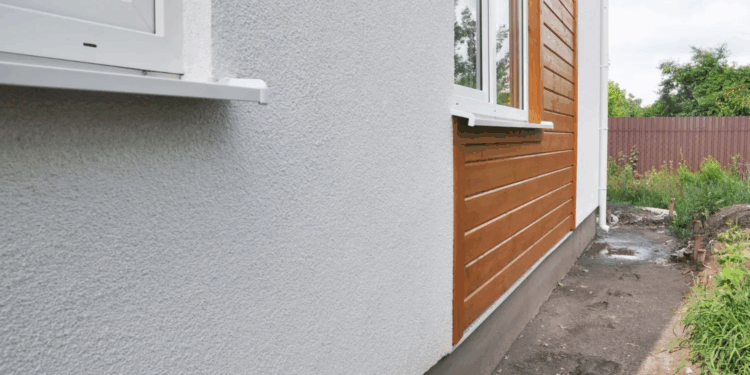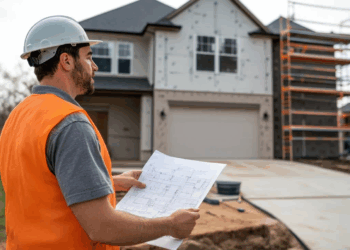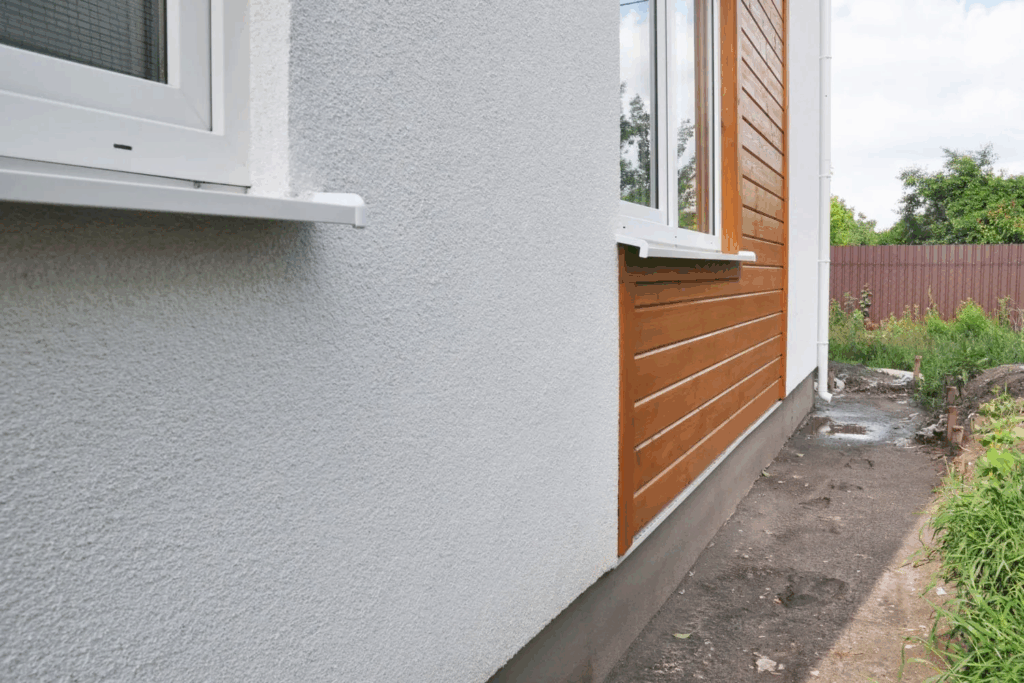
Embark on the decision between Siding vs Stucco: Which Exterior is Right for You? This introductory paragraph sets the stage for a detailed comparison to help you make an informed choice for your home.
Delve into the nuances of siding and stucco as we explore the factors that play a crucial role in determining the most suitable exterior for your needs.
Introduction
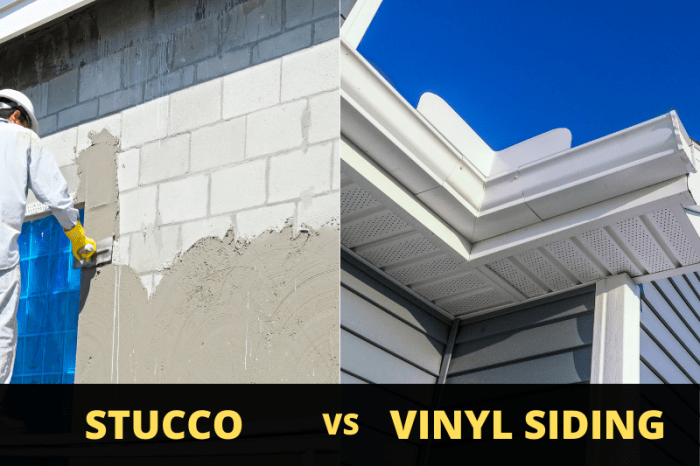
When it comes to the exterior of your home, choosing the right material is crucial for both aesthetics and functionality. Two popular options for home exteriors are siding and stucco, each offering unique benefits and considerations.
Siding refers to a material, such as vinyl or wood, that is installed on the exterior walls of a house to protect it from the elements and enhance its appearance. On the other hand, stucco is a cement-based mixture that is applied to the exterior walls to provide a durable and weather-resistant finish.
Key Factors to Consider
- Cost: Siding typically offers a more budget-friendly option compared to stucco, which can be more expensive due to its installation process.
- Maintenance: Siding may require more maintenance over time, such as painting or repairs, while stucco is known for its durability and minimal upkeep.
- Aesthetics: Consider the look you want to achieve for your home - siding comes in a variety of colors and styles, while stucco offers a more textured and traditional appearance.
- Climate: Think about the climate in your area - stucco is great for hot and dry climates, while siding may be more suitable for regions with fluctuations in temperature.
Siding Overview
When it comes to choosing the right exterior for your home, siding is a popular choice due to its durability, low maintenance, and versatility in design. There are various types of siding materials available, each with its own unique characteristics and benefits.Vinyl siding is one of the most commonly used materials, known for its affordability and ease of maintenance.
Wood siding offers a classic and natural look, but requires more upkeep to prevent rot and warping. Fiber cement siding is a durable option that can mimic the appearance of wood or stucco while being resistant to fire, insects, and rot.
Durability and Maintenance
- Vinyl siding is low maintenance and resistant to rot, fading, and pests.
- Wood siding requires regular maintenance such as sealing, painting, and repairs to prevent decay.
- Fiber cement siding is durable, resistant to fire and insects, but may require repainting over time.
Aesthetic Appeal and Versatility
- Vinyl siding comes in a wide range of colors and styles, offering versatility in design.
- Wood siding provides a classic and natural look, perfect for traditional and rustic architectural styles.
- Fiber cement siding can mimic the appearance of wood or stucco, offering a modern and sleek aesthetic.
Stucco Overview

Stucco is a popular exterior finish made of cement, sand, lime, and water. It is applied in multiple layers to create a durable, seamless surface on the exterior of a building.
Composition and Application Process
Stucco is typically applied in three coats: the scratch coat, brown coat, and finish coat. The scratch coat provides a base for the subsequent layers, while the brown coat adds strength and durability. Finally, the finish coat gives the stucco its texture and appearance.
The application process involves troweling on each layer and allowing it to cure between coats.
Benefits of Stucco
Energy Efficiency
Stucco is known for its thermal mass properties, which help regulate indoor temperatures and reduce energy consumption for heating and cooling.
Insulation
Stucco provides excellent insulation, helping to keep the interior of a building comfortable regardless of external weather conditions.
Durability
Stucco is resistant to fire, mold, and rot, making it a long-lasting option for exterior finishes.
Longevity and Cost Considerations
Stucco is a durable material that can last for decades with proper maintenance. While the initial cost of stucco installation may be higher than some other exterior finishes, its longevity and low maintenance requirements can result in cost savings over time.
Factors to Consider
When deciding between siding and stucco for your home's exterior, there are several factors to take into consideration. These factors include cost, weather resistance, durability, and environmental impact.
Cost of Installation and Maintenance
One of the primary factors to consider when choosing between siding and stucco is the cost of installation and maintenance. Siding materials such as vinyl or fiber cement are generally more affordable to install compared to stucco. Additionally, siding typically requires less maintenance over time, saving you money in the long run.
Weather Resistance and Durability
Another important consideration is the weather resistance and durability of siding versus stucco. While stucco is known for its durability and ability to withstand harsh weather conditions, some siding materials like fiber cement can also offer excellent durability and resistance to elements such as moisture and pests.
However, stucco may require more frequent maintenance to ensure it remains in top condition.
Environmental Impact
When it comes to the environmental impact of siding materials versus stucco, siding options like fiber cement are known for being eco-friendly and sustainable. These materials are often made from recycled content and can be recycled at the end of their lifespan.
On the other hand, stucco is a more natural material but may have a higher environmental impact due to the energy-intensive manufacturing process.
Design and Style
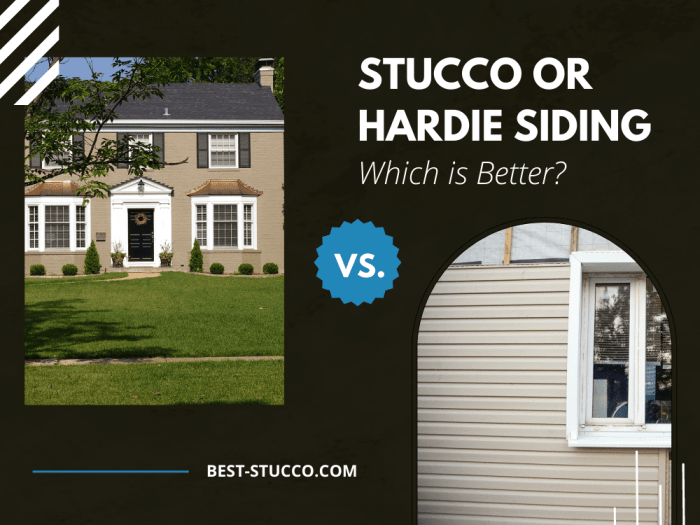
When it comes to the design and style of your home's exterior, both siding and stucco offer unique possibilities to enhance curb appeal and create a cohesive look that complements your home's architecture.
Enhancing Curb Appeal
- Siding: With a wide range of textures and profiles, siding can add depth and visual interest to your home. Whether you choose traditional vinyl siding or opt for a more modern fiber cement option, siding can be customized to suit your style.
- Stucco: Stucco provides a smooth and seamless finish that can give your home a clean and timeless look. Its versatility allows for different textures and colors to be incorporated, making it a popular choice for a classic and elegant appearance.
Color Options and Customization
- Siding: Siding comes in a vast array of colors, from bold hues to more muted tones, allowing you to personalize your home's exterior to reflect your unique taste. Some siding materials even offer the option to paint or stain for further customization.
- Stucco: While stucco is traditionally associated with neutral earth tones, modern advancements have expanded the color palette available for stucco finishes. From warm terracotta shades to cool greys, stucco offers a variety of color options to suit different architectural styles.
Architectural Features Influence
- Siding: Siding works well with homes featuring multiple gables, dormers, or other intricate architectural details. Its versatility allows for different siding styles to complement these features while adding visual interest.
- Stucco: Stucco is often chosen for homes with a more streamlined and minimalist architectural design. Its smooth finish can accentuate clean lines and modern aesthetics, making it a popular choice for contemporary homes.
Installation Process
When it comes to choosing between siding and stucco for your home exterior, understanding the installation process for each can help you make an informed decision. Let's delve into the typical installation procedures for siding and detail the steps involved in applying stucco to a home exterior, as well as any special considerations or challenges related to the installation of siding or stucco.
Siding Installation
- Prepare the exterior surface by removing any existing siding or repairing damaged areas.
- Install a moisture barrier to protect the home from water damage.
- Attach the siding material to the exterior using nails or screws, following manufacturer guidelines.
- Finish the installation by adding trim pieces and ensuring proper alignment and spacing.
Stucco Application Process
- Prepare the surface by cleaning it thoroughly and repairing any cracks or damage.
- Apply a scratch coat of stucco to create a rough surface for better adhesion.
- Add a brown coat to provide strength and durability to the stucco finish.
- Finish with a final coat of stucco, which can be textured or smooth based on preference.
Special Considerations:
- Installation of siding may require additional insulation for energy efficiency.
- Stucco installation can be more time-consuming due to the multiple coats needed.
- Both siding and stucco may require professional installation for optimal results.
Maintenance and Repairs
When it comes to the longevity of your home's exterior, proper maintenance and timely repairs are essential. Understanding the specific requirements for siding and stucco can help you keep your house looking great for years to come.
Siding Maintenance
- Regularly clean your siding with a mild detergent and water to remove dirt and grime.
- Inspect for any signs of damage such as cracks, warping, or discoloration, and address them promptly.
- Trim any nearby trees or bushes to prevent damage from branches rubbing against the siding.
- Consider applying a fresh coat of paint or sealant every few years to protect the material from the elements.
Stucco Maintenance
- Pressure wash the stucco exterior every 1-3 years to remove built-up dirt and debris.
- Regularly inspect for cracks, chips, or water damage, especially around windows and doors.
- Re-seal any cracks with a high-quality stucco patching compound to prevent further water infiltration.
- Apply a new coat of stucco paint or sealer every 5-7 years to maintain its appearance and protect it from fading.
Common Issues and Repair Solutions
- Siding:Common issues include moisture damage, rot, and insect infestations. Repair by replacing damaged panels, addressing any underlying moisture issues, and applying a protective finish.
- Stucco:Cracking, staining, and efflorescence are common problems with stucco. Repair by filling cracks with stucco patch, cleaning stains with a mild detergent, and addressing any underlying water drainage issues.
Summary
Concluding our discussion on Siding vs Stucco: Which Exterior is Right for You?, we've covered the essentials to guide you towards the ideal choice that aligns with your preferences and requirements.
FAQ Explained
Is stucco more energy-efficient compared to siding?
Stucco generally offers better energy efficiency due to its thermal properties and insulation benefits.
What is the typical lifespan of siding materials compared to stucco?
Siding materials like vinyl can last anywhere from 20-40 years, while stucco can have a lifespan of 50 years or more with proper maintenance.
Are there any specific weather conditions that favor siding over stucco or vice versa?
Siding may be more favorable in areas with extreme temperature variations, while stucco can perform well in regions with consistent climates.
